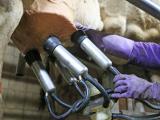Feb 3, 2006 (CIDRAP News) – A new test developed by federal experts offers preliminary detection of H5 avian influenza in human patients in about 4 hours, compared with 2 to 3 days for other methods, government officials announced today.
"This laboratory test is a major step forward in our ability to more quickly detect cases of H5 avian influenza and provides additional safeguards to protect public health," Health and Human Services Secretary Mike Leavitt said in a news release.
The test is to be used on respiratory samples from patients suspected of having avian flu on the basis of severe illness and possible exposure to sick birds, Dr. Steve Gutman of the Food and Drug Administration's (FDA's) Center for Devices and Radiological Health said at a news teleconference this afternoon.
The FDA announced its approval of the test, following an unusually quick 2-week review. The test, called the Influenza A/H5 (Asian Lineage) Virus Real-time RT-PCR Primer and Probe Set, was developed by the Centers for Disease Control and Prevention (CDC).
Because of the concern that H5N1 avian flu may lead to a human flu pandemic, "FDA acted quickly to evaluate and expedite CDC's request for approval of this test," Acting FDA Commissioner Andrew von Eschenbach stated in the news release. He said the rapid review did not compromise the quality of the review process.
Gutman said the test yields "a presumptive not a definitive positive." The test determines only the hemagglutinin (H) type of the virus; further testing is needed to confirm the result and identify the neuraminidase (N) type, officials said.
"The test provides preliminary results on suspected H5 influenza samples within four hours once a sample arrives at the lab and testing begins," the news release states. "Previous testing technology would require at least two to three days to render results."
The CDC will distribute the test to its Laboratory Response Network (LRN), consisting of about 140 labs throughout the country, many of them public health labs, officials said.
When LRN labs using the test get positive or equivocal results, they will send the sample to the CDC for confirmatory testing, which will take about 2 to 4 hours once the sample arrives, said Stephan Monroe, acting director of the CDC's Viral and Rickettsial Diseases Division.
Gutman said a negative result from the test does not conclusively rule out the possibility of avian flu. "It's not intended for general screening of people in the general population; it's for people with severe respiratory illness who might've been exposed to sick birds," he added.
The CDC is sharing the test with the World Health Organization (WHO) and its collaborating labs, which so far have included labs in the United Kingdom, Japan, and Australia, officials said.
Concerning use of the test by other labs outside the United States, Monroe said the CDC would distribute the technology only to labs that the CDC judges to have the technical capacity and biosafety measures to use the test properly.
The CDC is not charging other labs for the test and is not making money on it, Monroe said. So far the test has been strictly a government-funded project, he said.
CDC Director Dr. Julie Gerberding commented in the news release, "The use of this test by laboratories that are part of the LRN, in conjunction with other laboratory testing and clinical observations, may enable earlier detection of influenza cases caused by this specific virus and allow public health agencies to investigate sources of infection and more quickly respond with control and prevention activities."
See also:
Feb 3 FDA news release
http://archive.hhs.gov/news/press/2006pres/20060203.html
Feb 3 early release MMWR article
http://www.cdc.gov/mmwr/preview/mmwrhtml/mm55e203a1.htm?s_cid=mm55e203a1_e



















